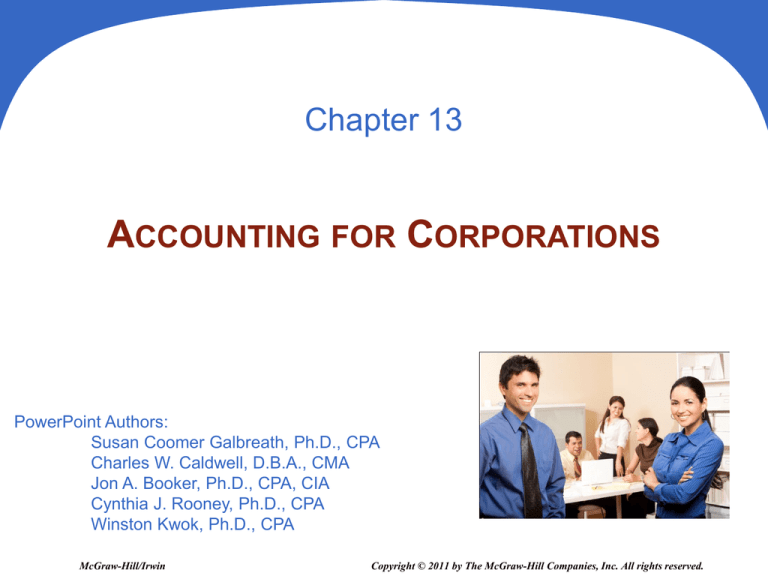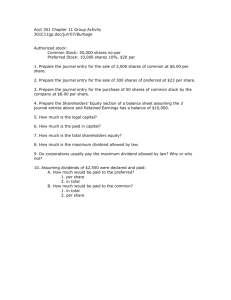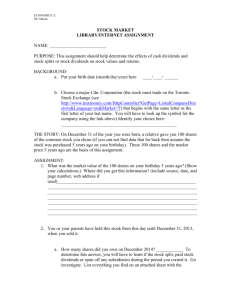
Chapter 13
ACCOUNTING FOR CORPORATIONS
PowerPoint Authors:
Susan Coomer Galbreath, Ph.D., CPA
Charles W. Caldwell, D.B.A., CMA
Jon A. Booker, Ph.D., CPA, CIA
Cynthia J. Rooney, Ph.D., CPA
Winston Kwok, Ph.D., CPA
McGraw-Hill/Irwin
Copyright © 2011 by The McGraw-Hill Companies, Inc. All rights reserved.
13 - 2
C1
CORPORATE FORM OF ORGANIZATION
An entity
created by law
Existence is
separate from
owners
Has rights and
privileges
Privately Held
Ownership
can be
Publicly Held
13 - 3
C1
CHARACTERISTICS OF CORPORATIONS
Advantages
Separate legal entity
Limited liability of shareholders
Transferable ownership rights
Continuous life
Lack of mutual agency for shareholders
Ease of capital accumulation
Disadvantages
Governmental regulation
Corporate taxation
13 - 4
C1
CORPORATE ORGANIZATION AND
MANAGEMENT
Shareholders
Board of Directors
President, Vice-President,
and Other Officers
Employees of the Corporation
13 - 5
C1
RIGHTS OF SHAREHOLDERS
Vote at shareholders’ meetings
Sell shares
Purchase additional shares
Receive dividends, if any
Share equally in any assets remaining after
creditors are paid in a liquidation
13 - 6
C1
BASICS OF SHARE CAPITAL
Total number of shares that a corporation
is authorized to sell or issue.
Shareholders' Equity
Share capital-Ordinary, par value $.01;
authorized 250,000,000 shares; issued and
outstanding 92,556,295 shares
$925,563
Total number of shares that has been
sold or issued to shareholders.
13 - 7
C1
BASICS OF SHARE CAPITAL
Par value is an
arbitrary amount
assigned to each
share when it is
authorized.
Classes of Shares
Par Value
No-Par Value
Stated Value
Market price is the
amount that each
share will sell for in
the market.
13 - 8
P1
ISSUING PAR VALUE SHARE
Par Value Share
On September 1, Matrix, Inc. issued 100,000
shares of $2 par value for $25 per share. Let’s
record this transaction.
Sept. 1
Dr
2,500,000
Cash
Share Capital-Ordinary, $2 par value
Share Premium-Ordinary
Issued 100,000 ordinary shares.
Cr
200,000
2,300,000
13 - 9
P1
ISSUING PAR VALUE SHARES
Shareholders' Equity with Ordinary Shares
Shareholders' Equity
Share Capital-Ordinary, $2 par value; 500,000 shares
authorized; 100,000 shares issued and
$ 200,000
outstanding
2,300,000
Share Premium-Ordinary
650,000
Retained earnings
Total shareholders' equity
$ 3,150,000
13 - 10
P1
ISSUING SHARES FOR NONCASH ASSETS
Par Value Shares
On September 1, Matrix, Inc. issued 100,000
shares of $2 par value for land valued at
$2,500,000. Let’s record this transaction.
Sept. 1
Dr
2,500,000
Land
Share Capital-Ordinary, $2 par value
Share Premium-Ordinary
Exchanged 100,000 ordinary shares for land.
Cr
200,000
2,300,000
13 - 11
P2
CASH DIVIDENDS
Regular cash dividends provide a return to investors
and almost always affect the share’s market value.
Corporation
Dividends
To pay a cash dividend, the
corporation must have:
1. A sufficient balance in
retained earnings; and
2. The cash necessary to
pay the dividend.
Shareholders
% of Corporations Paying Divends
100%
80%
75%
60%
40%
22%
20%
0%
Common
Preferred
13 - 12
P2
ACCOUNTING FOR CASH DIVIDENDS
Three important dates
Date of Declaration
Date of Record
Date of Payment
Record liability
for dividend.
No entry
required.
Record payment of
cash to shareholders.
13 - 13
P2
ACCOUNTING FOR CASH DIVIDENDS
On January 19, a $1 per share cash dividend is declared
on Dana, Inc.’s 10,000 ordinary shares outstanding. The
dividend will be paid on March 19 to shareholders of
record on February 19.
Date of Declaration
Record liability
for dividend.
Jan. 19
Retained Earnings
Ordinary Dividend Payable
Dr
10,000
Declared $1 per share cash dividend.
Cr
10,000
13 - 14
P2
ACCOUNTING FOR CASH DIVIDENDS
On January 19, a $1 per share cash dividend is declared
on Dana, Inc.’s 10,000 ordinary shares outstanding. The
dividend will be paid on March 19 to shareholders of
record on February 19.
No entry required on February 19, the date of record.
Date of Payment
Record payment of
cash to shareholders.
Mar. 19
Ordinary Dividend Payable
Cash
Paid $1 per share cash dividend.
Dr
10,000
Cr
10,000
13 - 15
P2
SHARE DIVIDENDS OR BONUS ISSUE
A distribution of a corporation’s own shares to its
shareholders without receiving any cash payment in return.
Why a share dividend?
Can be used to keep the market price on the shares affordable.
Can provide evidence of management’s confidence that
the company is doing well.
Capitalization: Transferring a portion of equity from retained
earnings to contributed capital.
13 - 16
P2
SHARE SPLITS
A distribution of additional shares to shareholders
according to their percent ownership.
$10 par value
Ordinary Shares
Old
Shares
100 shares
$5 par value
New
Shares
Ordinary Shares
200 shares
13 - 17
C2
PREFERENCE SHARES
A separate class of shares, typically having
priority over ordinary shares in . . .
Dividend distributions
Distribution of assets in case of liquidation
Usually has a stated
dividend rate
Normally has no
voting rights
13 - 18
C2
PREFERENCE SHARES
Cumulative
Dividends in arrears must
be paid before dividends
may be paid on ordinary
shares. (Normal case)
vs.
Noncumulative
Undeclared dividends from
current and prior years do
not have to be paid in
future years.
Consider the following Shareholders’ Equity section of
the Balance Sheet. The Board of Directors did not
declare or pay dividends in 2010. In 2011, the Board
declared and paid cash dividends of $42,000.
Share Capital-Ordinary, $5 par value; 40,000 shares
authorized, issued and outstanding
Share Capital-Preference, 9%, $100 par value; 1,000
shares authorized, issued and outstanding
Total Share Capital
$
200,000
$
100,000
300,000
13 - 19
C2
PREFERENCE SHARES
If Preference Shares Are Noncumulative:
Year 2010: No dividends paid.
Year 2011:
1. Pay 2011 preference dividend.
2. Remainder goes to ordinary.
Preference
$
-
If Preference Share Are Cumulative:
Year 2010: No dividends paid.
Year 2011:
1. Pay 2010 preference dividend in arrears.
2. Pay 2011 preference dividend.
3. Remainder goes to ordinary.
Totals
Preference
$
-
$
Ordinary
$
-
9,000
$
$
$
33,000
Ordinary
$
-
9,000
9,000
18,000
$
$
24,000
24,000
13 - 20
C2
PREFERENCE SHARES
Participating
Dividends may exceed a
stated amount once
common shareholders
receive a dividend equal to
the preferred stated rate.
vs.
Nonparticipating
Dividends are limited to a
maximum amount each year.
The maximum is usually the
stated dividend rate.
(Normal case)
Reasons for Issuing Preference Shares
To raise capital without sacrificing control
To boost the return earned by ordinary shareholders
through financial leverage
To appeal to investors who may believe the ordinary
shares are too risky or that the expected return on
common stock is too low
13 - 21
P3
TREASURY SHARES
Treasury shares are a company’s own shares
that have been acquired. Corporations might
acquire its own shares to:
1. Use their shares to buy other companies.
2. Avoid a hostile takeover.
3. Reissue to employees as compensation.
4. Support the market price.
13 - 22
P3
PURCHASING TREASURY SHARES
On May 8, Whitt, Inc. purchased 2,000 of its own
shares in the open market for $4 per share.
May 8
Treasury Shares-Ordinary
Cash
Dr
8,000
Cr
8,000
Purchase 2,000 treasury shares
at $4 per share.
Treasury shares are shown as a reduction in total
shareholders’ equity on the balance sheet.
13 - 23
P3
SELLING TREASURY SHARES AT COST
On June 30, Whitt sold 100 shares of
its treasury shares for $4 per share.
June 30
Dr
400
Cash
Treasury Shares-Ordinary
Sold 100 treasury shares
for $4 per share.
Cr
400
13 - 24
P3
SELLING TREASURY SHARES
ABOVE COST
On July 19, Whitt, Inc. sold an additional 500
treasury shares for $8 per share.
July 19
Cash
Treasury Shares-Ordinary
Share Premium-Treasury Shares
Dr
4,000
Sold 500 treasury shares for $8 per share.
Cr
2,000
2,000
13 - 25
SELLING TREASURY SHARES
BELOW COST
P3
On August 27, Whitt sold an additional 400
treasury shares for $1.50 per share.
Aug. 27
Cash
Share Premium-Treasury Shares
Treasury Shares-Ordinary
Dr
600
1,000
Sold 500 treasury shares for $1.50 per share.
Cr
1,600
13 - 26
C3
STATEMENT OF COMPREHENSIVE INCOME
Statement of
Comprehensive
Income (SCI)
All non-owner
changes in equity +
other
comprehensive
income
Can be 2
statements: Income
statement + SCI
13 - 27
C3
STATEMENT OF CHANGES IN EQUITY
Statement of
Changes in
Equity (SCE)
All owner changes
in equity,
including changes
in accounting
policies
Dividends
13 - 28
C3
RESERVES
Most
reserves result from accounting standards
to reflect certain measurement changes in equity
rather than the income statement, e.g. asset
revaluation reserve, foreign currency translation
reserve and other statutory reserves.
Retained earnings also called revenue reserves.
Ending Retained Earnings =
Beginning Retained Earnings + Net Income – Dividends
A company’s cumulative net income less any net losses and
dividends declared since its inception.
13 - 29
A1
EARNINGS PER SHARE
Earnings per share is one of the most widely
cited accounting statistics.
Basic
earnings =
per share
Net income - Preference dividends
Weighted-average ordinary shares outstanding
13 - 30
A2
PRICE–EARNINGS RATIO
This ratio reveals information about the stock
market’s expectations for a company’s future growth
in earnings, dividends, and opportunities.
Price–
Earnings
Ratio
=
Market value per share
Earnings per share
13 - 31
A3
DIVIDEND YIELD
Tells us the annual amount of cash dividends
distributed to ordinary shareholders relative to
the share’s market price.
Dividend
Yield
=
Annual cash dividends per share
Market value per share
13 - 32
A4
BOOK VALUE PER
ORDINARY SHARE
Reflects the amount of shareholders’ equity
applicable to ordinary shares on a per share basis.
Shareholders’ equity applicable
Book value per
to ordinary shares
=
ordinary share
Number of ordinary
shares outstanding
13 - 33
END OF CHAPTER 13








